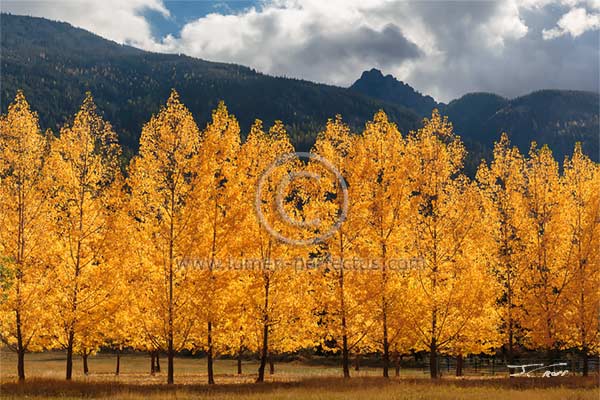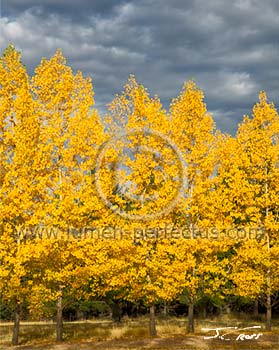www.lumen-perfectus.com
The Trees Are Calling
“I speak for the trees, for the trees have no tongues.”
The Lorax (Dr. Suess)
Those of us who've come to the Rocky Mountain west from the eastern U.S. have learned that autumn is different here. Pat and I lived in the hardwood forest of northeastern Ohio, surrounded by maple, beech, and oak, along with softer trees like willow and birch. We expected lovely fall color and were rarely disappointed. Sometimes an early snow storm, or more likely, ice storm, would strip the leaves from trees before they'd reached peak fall color. Those storms could be damaging, shredding leaves and breaking branches, but generally came later, after the trees had lost most of their leaves.
I've heard from people who think we don't have fall color here in the west, but it's not true. One soon learns to look down to see most of it. When the nights get chilly and the days clear and crisp we begin to find beautiful color in ferns, various berries and shrubs (huckleberry, serviceberry, snowberry, Oregon grape, Sitka mountain ash, chokecherry, others), and a wide variety of grasses. Most of these plants grow no more waist-high; a few may reach heights of ten to fifteen feet (three to five meters). Look down when wandering the hillsides or forests or riparian areas; there's plenty of color to be found. Of course, we have deciduous trees that make nice color in autumn: some maples with their reds and oranges, spectacular larches blazing yellow on mountainsides among the green pines and firs. And we have the brilliant gold of cottonwood and aspen along riverbanks and elsewhere if there's plentiful water.
A Long and Lovely October

Morning sun backlights the cottonwoods with the Mission Range in shadow as a backdrop.
This fall, 2015, has been spectacular, on par with 2014, which was one of the longest, and prettiest, in memory. This year, like last, October seemed to last far longer than the usual 31 days. Most every day was warmer than “normal”, whatever that means now. Many of October's days offered typical autumn puffy clouds against brilliant blue sky. An equal number of perfectly clear, blue-sky days filled out the month. Generally, clear blue skies aren't great for photography, or at least, not my preference, but one can't argue that sunny days feel really good late in the month when temperatures finally begin to drop.
One of those clear days prompted friend Marie to send a photo she'd snapped with her iPhone, of a stand of aspen trees on the property across the road from her house. This stand of nearly identical trees, blazing yellow in late-morning sun, had clearly been planted, giving the overall scene a somewhat artificial look. Marie's composition centered the long line of trees in the frame, against a background of the Mission Mountains under a nearly clear blue sky. It's a very nice photo, and left me with no choice but to ask the landowner's permission to visit the property and try some compositions of my own. This property is owned by mutual friends; a few days later Marie, Pat and I visited them, talked a bit, and got the OK. I made my first attempt later that evening.
As Many As It Takes

One of the photos made from atop a ladder, creating a viewpoint that lowered the tops of the trees below the mountain ridge line.
The setting sun lights the trees, and also the west-facing slopes of the Mission Range. That first outing left me wanting to try a morning shoot; the sun would rise over the mountains and back-light the trees, but the mountains would remain in shadow (I hoped) for a little while, making a nice backdrop to the brilliant yellows of the leaves. I returned the next morning, and while waiting for the sun to clear the mountains (nearly 10:00, somewhat later than I'd anticipated) I wandered the property looking for nice compositions.
I mentioned that the scene looked a bit artificial. In fact, the 50 trees had been planted in a large oval surrounding a horse corral. I later learned from the land owner that years ago they'd planted these trees as foot-tall bare-root saplings. She said these are poplar trees, not aspens. A little research, with help from people far more knowledgeable than I, determined the trees are most likely plains cottonwoods (also called plains aspens), similar to the eastern aspen, which doesn't grow this far west. Cottonwoods, aspens, and some willows are in the genus Populus, so they share a number of traits and are easily confused by those less well versed in botany (that would include me). Whether poplars, cottonwoods, or aspens, they are gorgeous, and in a perfect setting. As the trees surround a corral, most of my photos are looking through them, through both sides of the coral, adding to the density of the foliage.

A few of the trees against nicely lit clouds.
I returned to the trees several times. After each trip I inspected the new photos, always finding reasons to go back to try again. I visited five times, three in the morning, two in the evening, before deciding I'd gotten the best I was going to get. On several of those trips I brought along a five-foot ladder. For some of the photos I climbed the ladder, bracing my tripod as a monopod on the top step, the higher viewpoint helping to lower the tops of the trees just slightly below the line of the mountain tops. I thought if the trees didn't break that ridge line it would make a nicer composition. In the end I think it doesn't matter much, but I do slightly prefer those pictures.
I also made a number of exposures to assemble as panoramas. These are less successful than I'd hoped, but it was worth a try. In the end, the photos presented here are my favorites, including one in which I stood in the middle of the coral, turned my back on the mountains, and photographed a small group of the trees against an impressively cloudy morning sky.
This isn't the first time I've been the beneficiary of a heads up from Marie. She'll tell you otherwise, but she's got a good eye, and she makes good use of the camera in her phone. She also lives in a place surrounded by really good subject material! Thanks yet again, Marie, and thanks also to those who planted the trees decades ago and allowed me on their land to make the pictures.
November, 2015